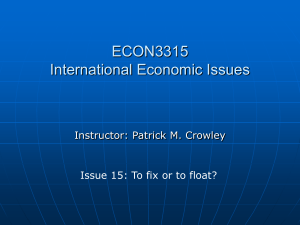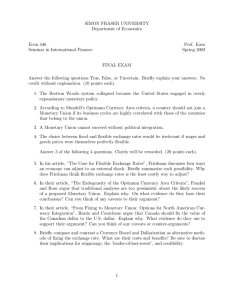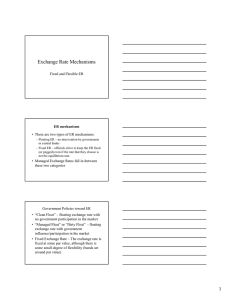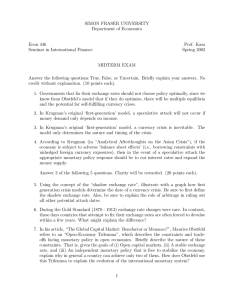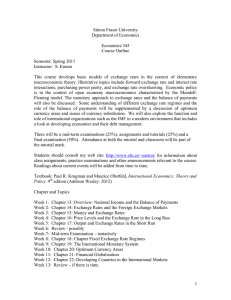Exchange Rate Regimes Lecture 2 IME LIUC 2010 1
advertisement
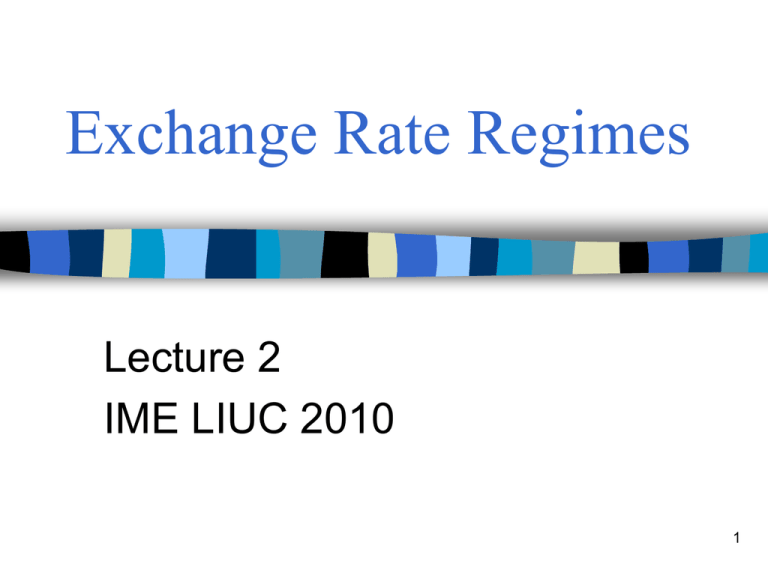
Exchange Rate Regimes Lecture 2 IME LIUC 2010 1 How many exchange rate regimes do we have? Conventionally 3 broad categories: Hard pegs, soft pegs, floating arrangements But it is more complicated: 1) de jure vs de facto exchange rate arrangements, 2) differences within each broad category The IMF publishes: Annual Report on Exchange Rate Arrangements and Exchange Rate Restrictions According to the IMF classification (revised in 2009): Hard pegs (23 countries or 12.3%): ER with no separate legal tender (10 countries) The country adopts a foreign currency as legal tender. Currency boards (13 countries) 2 Soft regimes (78 countries or 41.5%) Conventional pegged arrangements the country formally (de jure) pegs its currency at a fixed rate to another currency or a basket of currencies, where the basket is formed, for example, from the currencies of major trading or financial partners, and weights reflect the geographic distribution of trade, services, or capital flows. Stabilezed arrangements A spot market exchange rate that remains within a small margin because of official action but no commitment on the part of the country authorities. Pegged exchange rates with horizontal bands The central bank keeps the exchange rate inside a preannounced band by intervening in the foreign exchange market (de jure) 3 Crawling pegs The central bank preannounces a periodic rate of depreciation and supports the preannounced path for the exchange rate by intervening in the foreign exchange Crowl-like arrangements Crawling pegs but de facto Floating arrangements (75 countries or 40.2 %): Floating Exchange rate is largely market determined, limited interventions prevent undue fluctuations. Free Floating Intervention occurs only exceptionally, Other arrangements (12 countries, 6 %) 4 What is a currency board (CBA)? A CBA is a monetary arrangement based on an explicit legislative commitment to exchange domestic currency for a specified foreign currency at a fixed exchange rate, combined with restrictions on the issuing authority. This implies that domestic currency will be issued only against foreign exchange and that it remains fully backed by foreign assets, eliminating traditional central bank functions such as monetary control and lender-of-last-resort, and leaving little scope for discretionary monetary policy. 5 Advantages and Disadvantages of Fixed and Flexible ER Advantages of fixed exchange rates – 1) providing a nominal anchor to monetary policy – 2) encouraging trade and investment – 3) precluding competitive depreciation – 4) avoiding speculative bubbles Advantages of floating exchange rates – 1) giving independence to monetary policy – 2) allowing automatic adjustment to trade shocks – 3) avoiding speculative attacks 6 Fixed ER:1) nominal anchor to monetary policy A central bank that wants to fight inflation can commit more credibly by fixing the exchange rate Workers, firm managers, and others who set wages and prices then perceive that inflation will be low in the future because the currency peg will prevent the central bank from expanding even if it wanted to. When workers and firm managers have low expectations of inflation, they set their wages and prices accordingly. The result is that the country is able to attain a lower level of inflation for any given level of7 output. Fixed ER:2) encouraging trade and investment ER variability would create uncertainty and would discourage international trade and investment. In the past, skepticism for three reasons – Exchange rate variability reflects variability in economic fundamentals. – Anyone adversely affected by exchange rate variability can hedge away the risk – empirically, it was hard to discern an adverse statistical effect from increased exchange rate volatility on trade. Counterarguments – most exchange rate volatility appears to be unrelated to macroeconomic fundamentals. – many developing country currencies have no forward markets; – Third, more recent econometric studies have found stronger evidence of an effect of exchange rate variability on trade 8 Fixed ER:3) precluding competitive depreciation Argument that goes back to the 30’ (1929 crisis) In countries that are interdependent, the depreciation by one country put pressure on the others. E.g. each time one country in East Asia or Latin America devalued, its neighbors were instantly put at a competitive disadvantage, (e.g., from Thailand to the rest of East Asia in 1997, and from Brazil to the rest of South America in 1999). 9 Fixed ER:4) avoiding speculative bubbles The final argument for fixed exchange rates is to preclude speculative bubbles of the sort that pushed up the dollar in 1985 or the yen in 1995. According to some economists, the strong appreciation of US$ in 1985 the was not determined by fundamentals, but rather was the outcome of self-confirming market expectations (speculative bubble). Some exchange rate fluctuations appear utterly unrelated to economic fundamentals.Therefore, fixing the exchange rate is a way to avoiding the bubbles 10 Flexible ER:1) giving independence to monetary policy i IS LM y 11 Flexible ER:2) allowing automatic adjustment to trade shocks i IS LM y 12 How to choose? Main findings of a recent study: 1) pegged ex rate regimes are associated with the best inflation performance 2) growth performance is best under intermediate regime 3) trade links stronger under pegged regimes 4) peg and inter regimes have some drawbacks: severely constrain the use of other macro policies, greater susceptibility to crises, impede timely external adj. 13 Ghosh – Ostry : Ex rat Regimes and the Stability of the IMS IMF occ pap. N. 270, 2010
